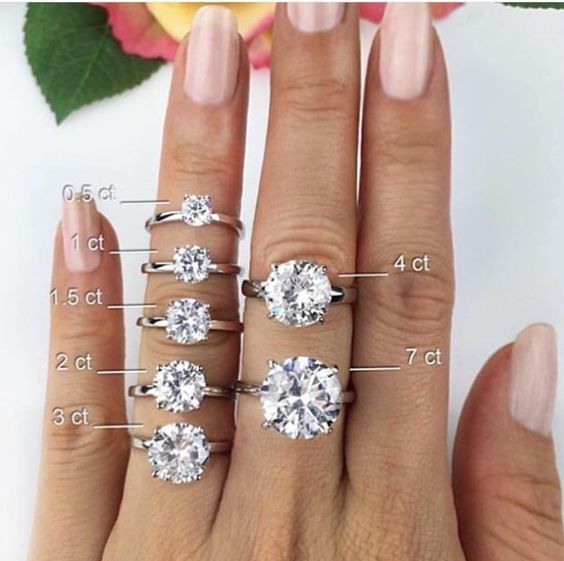The allure of engagement rings transcends mere ornamentation; it symbolizes a deeply rooted cultural tradition that binds individuals in promises of love and commitment. Among the myriad modifications and styles available, the 1-carat diamond remains a perennial favorite. But what drives the fascination with this particular size and its accompanying costs? Let us delve into the intricacies of pricing, societal influences, and the psychological implications behind purchasing a 1-carat engagement ring.
First and foremost, the average cost of a 1-carat engagement ring can fluctuate widely based on several pivotal factors, including cut quality, color grading, clarity, and the overall market demand. Customarily, one might expect to pay anywhere from $3,000 to $7,000 for a 1-carat diamond, although prices may soar significantly for exceptional specimens or designer settings. The ‘Four Cs’—cut, color, clarity, and carat weight—are essential parameters that directly influence the valuation of diamonds. Among these, cut is often deemed the most critical, as it affects the diamond’s brilliance and sparkle, an essential characteristic that buyers seek.
Diamonds of the same weight can differ dramatically in appearance depending on their cut. An exquisitely cut diamond appears larger and more luminous than a poorly cut counterpart of identical weight. As such, consumers must weigh the implications of their selection carefully. A ring that captures light effectively can elevate the perception of size, thus creating an illusion that may satisfy the aesthetic desires of the wearer. In contrast, a seemingly larger, poorly cut diamond might lack the scintillation and charm one hopes to find.
Moreover, the color grading of a diamond ranges from completely colorless (D) to light yellow or brown (Z). Those desiring the quintessential “white” diamond will focus on stones graded between D and G. As the color grade descends, so too does the value and desirability. This delves into a psychological phenomenon—the perception of rarity elevates desirability, hence the premium pricing for near-colorless stones.
Clarity, denoting the presence of internal or surface imperfections, also plays a crucial role in the evaluation of a diamond. A perfectly clear stone, graded as Flawless (FL), is exceedingly rare, and collectors or engaged couples alike are willing to pay a premium for such pristine specimens. In practice, many opt for diamonds graded SI1 (Slightly Included 1) or VS2 (Very Slightly Included 2), which offer a commendable balance of quality and cost. This pragmatic approach reveals a deeper intertwining of financial considerations with romantic aspirations.
Market dynamics, influenced by retail markups and brand reputation, can also skew perceptions of a 1-carat diamond’s average cost. Renowned jewelry establishments tend to price their engagement rings at a premium. Conclusively, one’s choice to purchase from an established retailer or an artisanal jewelers may shape the overall financial commitment, as varying markups play a pivotal role in determining final pricing levels.
Beyond these tangible aspects lies an intertwined narrative—cultural expectations and societal influences. The “two months’ salary” guideline once held considerable sway, dictating that a gentleman should spend approximately a quarter of his annual earnings on his betrothed’s ring. This cavalier rule constructed an implicit standard that many still adhere to, further complicating the conversation around the average cost of engagement rings. Herein lies a profound societal observation: the ring has become both a status symbol and an embodiment of one’s commitment, leading individuals to confront their values around love, materialism, and financial stewardship.
However, it is essential to recognize the myriad alternative options available, prompting a shift in perspective regarding what constitutes a meaningful engagement ring. Increasing popularity of lab-grown diamonds, moissanite, and even less traditional gemstones challenges erstwhile norms dictating diamond engagement rings. These alternatives often possess an allure of ethical grounding and cost-effectiveness, breaking the cycle of prioritizing carat weight over personal meaning or ethical considerations. With rising awareness around issues of conflict diamonds and the environmental impact associated with mining, purchasing habits have begun to reflect a more conscientious approach. This pivot can often reflect both societal values and personal ethics, rendering the pursuit of engagement bling an evolving topic.
An essential aspect of this discussion revolves around the emotional motivations that drive couples to invest in engagement rings at all. On one hand, the desire for a physical token of commitment is universal. On another, the societal constructs surrounding love and marriage place increasing weight on the appearance of that token. Partnered individuals often find themselves negotiating their expectations, contemplating factors such as aesthetic appeal, historical reputation, and financial implications.
The psychological ramifications extend beyond just those involved in the transaction. Family, friends, and societal circles can exert considerable influence over individuals’ perceptions of what constitutes a fitting engagement ring. The quest for approval and acceptance can lead couples down the rabbit hole of expensive purchases, ultimately raising questions about the intrinsic value associated with material items versus emotional connectivity.
Consequently, as the average cost of a 1-carat engagement ring escalates in line with societal pressures and expectations, the invitation to focus on broader values becomes more salient. Reflecting on personal choice, ethical considerations, and financial circumstances may empower individuals in their engagements. Ultimately, the most significant value lies not solely in the bling itself but in the commitment it represents—an enduring promise of love rather than an emblem of wealth.
As society continues to evolve, so too will perceptions surrounding engagement rings and their associated costs. Innovations in the jewelry sector and shifts in consumer values pave the way for a new era—a time when emotional resonance supersedes ostentation, and meaningful choices take precedence over making a statement. The ring bling might dazzle the eye, but it is the story it encapsulates that shines the brightest.
